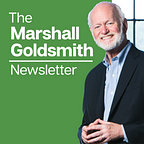How to Stand Out as An Executive Coach
I get paid only after my coaching clients have achieved positive change in key leadership behaviors and become more effective leaders. It is in this “pay-for-results” fee arrangement that I truly stand out from other coaches. How do you stand out? Learn more in this week’s Newsletter!
Jim Masters: Talk about, also, becoming an Executive Coach. How did you become a world renowned Executive Coach? What’s that process like?
Dr. Marshall Goldsmith: Well, there are all kinds of different times types of coaching. My type of coaching is very specific. I, number one, don’t get paid if my clients don’t get better.
Jim: Which is different. That’s rare, right?
Marshall: Very rare, very rare. So I have a very unique billing system. Better is not defined by me or them. It’s shoved right around them. So my job is just helping successful leaders achieve positive lasting change in behavior. And again, I’m not saying that’s the only definition of coaching. That’s just what I do.
Jim: That’s what you do.
Marshall: So I interview people around my clients. I help them develop a profile. Here’s what you’re doing well, here’s what you need to do better. We reach an agreement. These are the right behaviors and your key stakeholders. These are the right stakeholders. Then what happens is I work with you for a year to a year and a half, and if you achieve very positive lasting change in behavior as judged by those people over this time period, I get paid. And if you don’t, it’s all free.
Jim: So in terms of the people that you work with, are you looking for a certain type of person? Are there certain qualities? Are they at a certain level before you work with them?
Marshall: Well, a couple of things. One, the level, they’re CEOs or could be CEOs of huge organizations. My coaching process works equally well with first-line supervisors. Over 1,800 people have been certified in my coaching process. Tens of thousands of people from around the world have used it. Many with great, great success. And it’s a very transferrable process. My personal coaching though, is usually… well, it’s almost always CEOs or could-be CEOs of huge companies. And they’re helping the CEO get better and be a great role model or helping the CEO develop that next future CEO.
Jim: What do you think this desire comes from within you to do this work?
Marshall: Well, I just love the work. I’m sure I’m going to work until I die. I hope so. I don’t really want to play bad golf with old men at the country club, eating chicken sandwiches and discussing gallbladder surgery. So I love what I do and I love it in different ways. I love the speaking part because it’s just fun for me. I enjoy it. It’s like entertainment. It’s fun. Then the coaching part I like because of learning, and then the writing is how you reach people. And then of course, now we have the internet where the last blog I wrote, 130,000 people read it. I did the most popular video ever done on LinkedIn. So you reach thousands and thousands of people, which is a great opportunity. And it’s nice. Anytime I get an email, somebody says, “I read something, you did something, helped me a little bit.” It makes me feel great.
Jim: It’s an incredible variety of people that you’ve worked with too, like you said, Alan Mulally, the CEO from Ford, the leader of Girl Scouts. It’s a breadth of people from all different areas, genres.
Marshall: Totally different. Different countries. I’ve been the coach of the head of the Islamic Bank in Saudi Arabia, one of the biggest infrastructure companies in India, companies in France and the UK, all different kinds of people.
